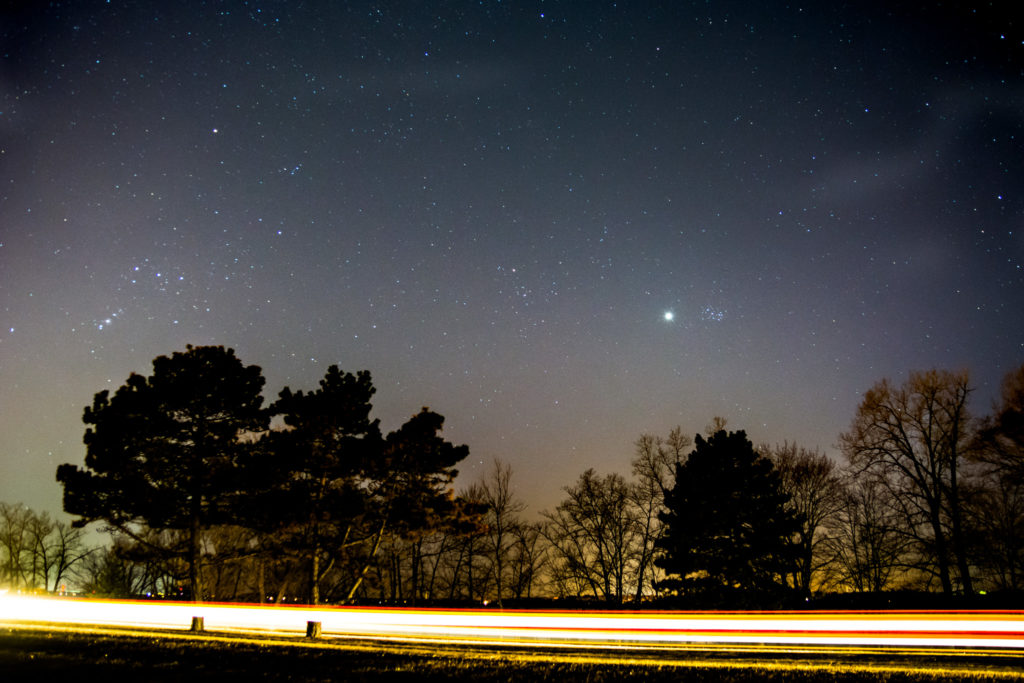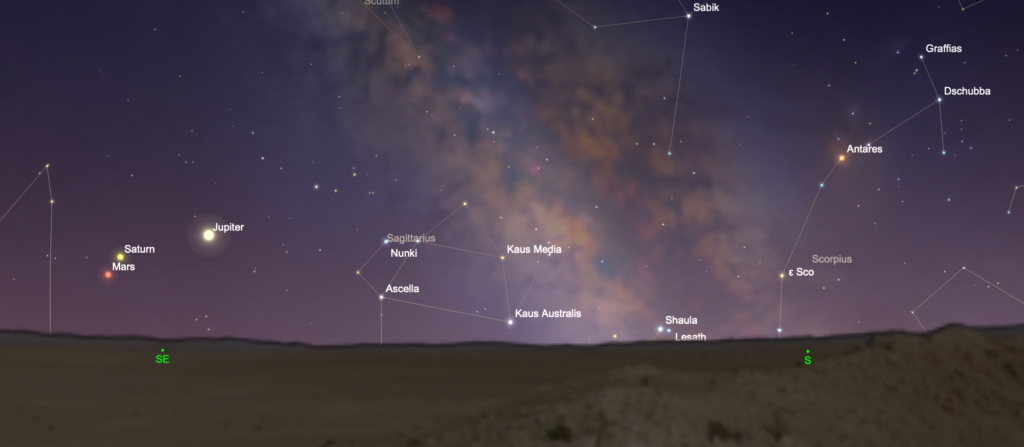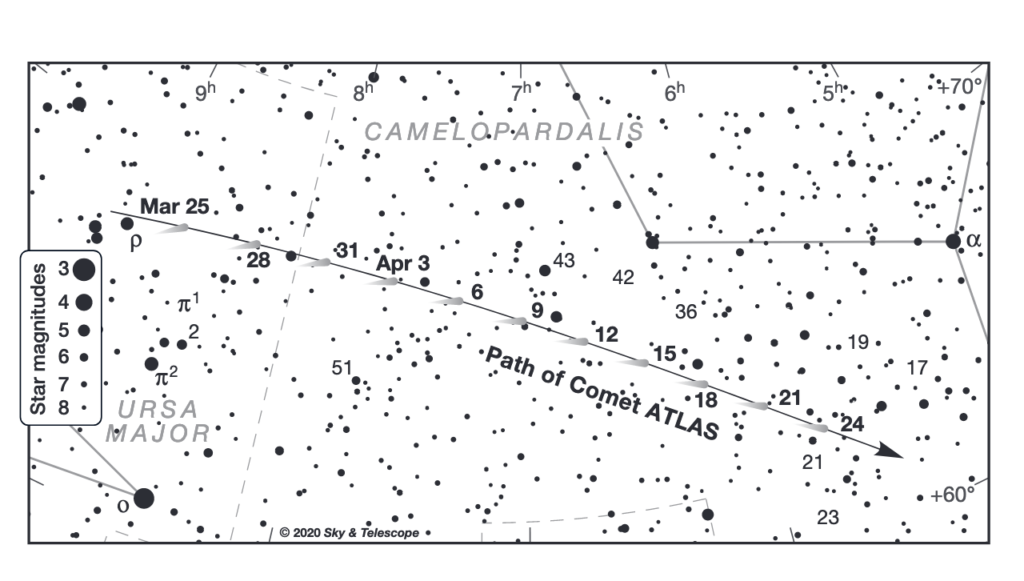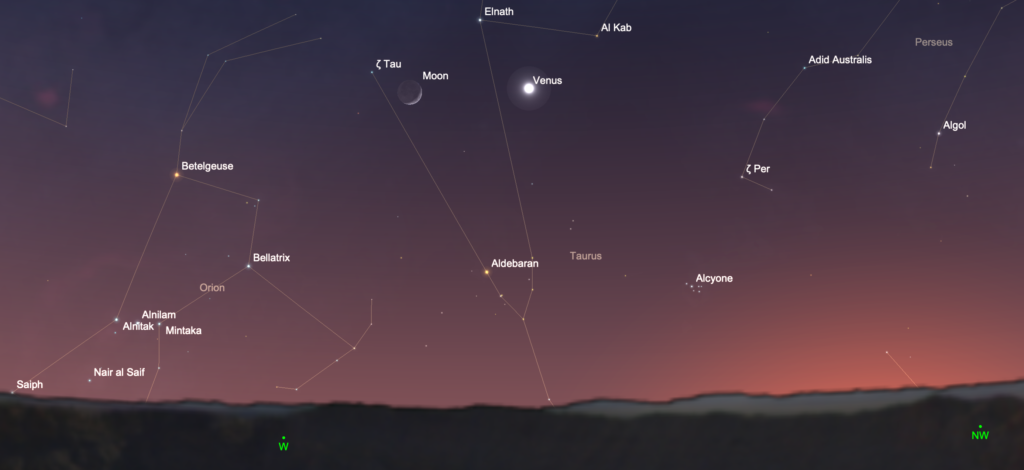
Pestilence has arrived on our tiny planet, along with a lingering fear that things may be generally going off the rails. But in such times we can still take solace in the few immutable pleasures of life: beauty, philosophy, friends and family, and the stars.
And there are plenty of stars (and planets) to see this month. The brilliant constellations Taurus, Orion, and Canis Major turn to the west after sunset and are on their way out for the year. Jupiter, Saturn, and Mars rise earlier each night, blazing together splendidly before dawn in the east-southeast on their way to excellent apparitions later this year. Venus makes a remarkably close approach to the Pleiades and slowly grows in brightness each night as the “Evening Star”. And a respectable meteor shower arrives later in the month in a dark and moonless sky.
And what’s this? A potentially bright comet is on its way to the inner solar system? Comet ATLAS (C/2019 Y4), the last comet discovered in 2019, is brightening quickly and may become a modestly spectacular naked-eye comet in the coming weeks. Stay tuned for more at Cosmic Pursuits on this promising comet, but for now northern-hemisphere observers can just glimpse Comet ATLAS in dark sky with a pair of binoculars.
Here’s what’s going on in the night sky this month…
1 April 2020. First Quarter Moon, 10:21 UT.
2 April. While Venus puts on a great show in the evening sky, Jupiter, Saturn, and Mars congregate in the pre-dawn sky all month. As April begins, Mars and Saturn lie within a couple of degrees of each other, with Jupiter about two fist-widths to the west. Mars moves quickly eastward this month relative to Saturn, while Jupiter and Saturn grow a little closer as April progresses. At magnitude -2.1, Jupiter far outshines the other two planets which begin the month at magnitude +0.7. All three planets brighten and grow larger in apparent size on the way to their respective oppositions in July (for Saturn and Jupiter) and October (for Mars).

3 April. It happens just once every 8 years, but this evening the dazzling planet Venus passes through the outskirts of the Pleiades star cluster. Look for this remarkably beautiful conjunction high in the western sky as darkness falls. The event looks great to the unaided eye, in binoculars, or in a small telescope at low magnification. It’s a more challenging proposition to capture a good image of this conjunction since Venus vastly outshines the Pleiades, but if you’re handy with a camera, give it a try. Venus and the Pleiades will be even closer the next time around on April 3, 2028.
8 April. Full Moon, 2:23 UT.
April 12-14. Watch in the early-morning sky in the east-southeast to see a waning gibbous Moon pass south of (from west to east) Jupiter, Saturn, and Mars. The three planets span a line about 20o long through the constellations Capricornus and Sagittarius.
14 April 2020. Last Quarter Moon, 22:56 UT.
15-30 April. As the Moon gets out of the way for the next 10 days or so, this is a perfect time to have a look for Comet ATLAS (C/2019 Y4). The comet began April at 8th magnitude, respectably bright for binocular observers, but its light is spread over nearly a quarter degree so it has a faint surface brightness. The comet will continue to brighten on its way to its closest approach to the Sun on May 31. Comets are unpredictable, but this one may reach naked-eye brightness by mid May. As of mid April, the comet lies in the constellation Camelopardalis (the Giraffe). The map below, courtesy of Sky & Telescope shows you where to look between the stars Omicron Ursa Majoris and Alpha Cam.

You can check on recent updates on the brightness of the comet at Seiichi Yoshida’s website which gives a weekly update on bright comets at this link.
And here’s a splendid image of the comet speeding past galaxies M81 and M82 a couple of weeks ago.
(It’s been a long time since a bright comet graced the northern skies. Here’s a recent piece on the last northern Great Comet, Hale-Bopp, which reached its brightest almost exactly 23 years ago). And during northern spring 50 years ago, Comet Bennett made a similar spectacular appearance (see image below).

21-22 April. The Lyrid meteor shower peaks. Look for meteors that trace their apparent paths back to a point between the constellations Hercules and Lyra, both of which rise in the east around midnight. You can see these meteors at any time of night, from nearly anywhere on Earth, but you may have more luck after midnight as the Earth turns into the meteor stream and the first quarter Moon sets. The shower typically produces 15-20 meteors per hour, but some years have yielded surprise outbursts of several hundred per hour. The Lyrids, which have been observed for at least 2,500 years, originate as the Earth passes through a stream of debris left by Comet C/1861 G1 (Thatcher). The Moon stays out of the way this year, so this presents a great chance to see some ancient stardust blaze its way through our upper atmosphere.
23 April. New Moon, 2:26 UT.

26 April. Look for the waxing crescent Moon in the evening sky tangled amid the “horns” of the constellation Taurus in the western sky after sunset. Venus, essentially now as bright as it ever gets, adds to the beauty.
27 April. Venus reaches peak brightness tonight at magnitude -4.7. The planet has been descending in the sky as it moves closer to Earth and quickly grows larger in apparent size. Today the planet appears about 27% illuminated and spans about 38”. The planet’s striking crescent shape is large enough to spot in any telescope and even in a good pair of binoculars. Records dating back to ancient Mesopotamia suggest the crescent-shape of Venus is visible without optical aid to those with exceptional vision.
The planet continues to move quickly each night towards the horizon on its way to superior conjunction with the Sun on June 3.